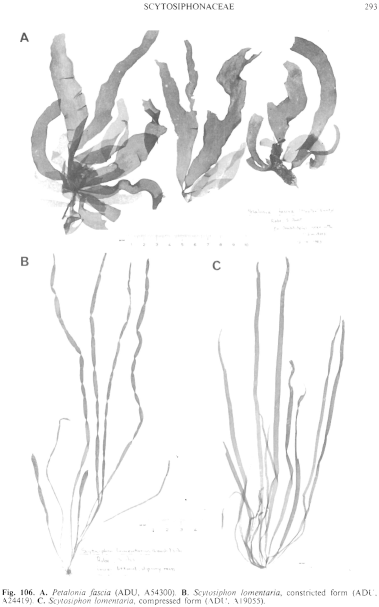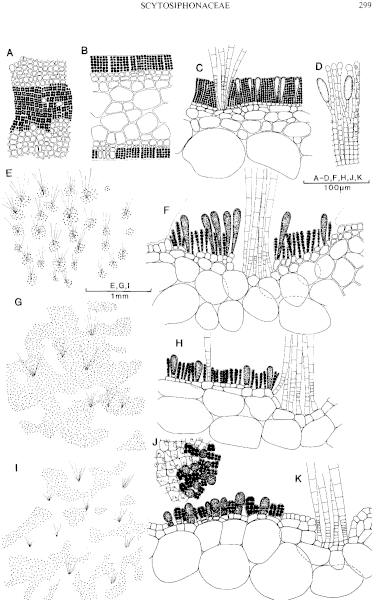|
|
|
|
|
|||||||||||
|
Electronic Flora of South Australia Species Fact Sheet
Phylum Phaeophyta – Order Scytosiphonales – Family Scytosiphonaceae
Selected citations: Clayton 1976a: 201, figs 1–7. Lindauer et al. 1961: 256, fig. 66. Nakamura & Tatewaki 1975: 59, figs 1–5, p1.1. Pedersen 1980: 391, figs 1–18. Rosenvinge & Lund 1947: 27, fig. 9. Setchell & Gardner 1925: 531, pl. 44 figs 72, 74. Womersley 1967: 246.
Synonym
Petalonia zosterifolia sensu Womersley 1967: 245.
Thallus (Fig. 106B,C) medium to dark brown, erect, 5–30 (–76) cm high, terete and hollow and often constricted (Fig. 106B) at intervals of 1–3 cm, or compressed (Fig. 106C) to varying degrees and partly hollow or with the sides adjacent but easily separated, (0.5–) 1–5 (–8) mm in diameter or broad, with each frond tapering from the broader mid thallus towards the base and the apex, attached by a small discoid holdfast 100 µm to 1 mm across which bears 1 to numerous erect fronds; epilithic or occasionally epiphytic on seagrasses. Structure polystichous, with a medulla 2–4 (–6) cells broad (Fig. 108C), grading to the cortex 2–3 cells thick, outer cells small, isodiametric (to L/B 2), 4–6 (–8) µm across, each with a single phaeoplast and pyrenoid. Phaeophycean hairs single or usually in groups, profuse, becoming sunk in a pit, 5–8 (–10) µm in diameter. Crustose stage discoid, ralfsioid, 2 mm-5 cm across and 60–100 µm thick when sterile, with radiating basal filaments, monostromatic at the margins, and erect filaments from most cells (Fig. 108D); cells of erect filaments 7–9 µm in diameter, L/B 0.6–1.4; phaeophycean hairs in scattered groups, 5–6 µm in diameter.
Reproduction: The erect phase with sort of plurilocular organs (Fig. 108C), at first discrete and often pulvinate or elongate, extending over most of the surface, the zooidangia (20–) 30–40 µm and (6–) 10–14 locules long, with 4–6 rows corresponding to each cortical cell, each row uniseriate with occasional divided locules, 2–3 µm in diameter; zooids mostly acting as mitospores and giving rise to erect, terete or compressed, thalli under winter (short day) conditions, and to crustose thalli in summer conditions, with the zooids acting as gametes (slightly anisogamous from dioecious thalli) between August and October (Clayton 1980, 1981b). Paraphyses frequent amongst the plurilocular organs, simple (rarely divided into two), clavate, pyriform or shortly linear, (20–) 30–40 µm long and 8–12 (–15) µm in diameter, usually packed with physodes, extending to the surface or beyond the reproductive organs, remaining after the latter have been lost.
Type from Quivig, Faroe Is; in Herb. Lyngbye, C.
Selected specimens: Cottesloe, W. Aust., on jetty piles (Smith, Sept. 1945; ADU, A2094). Wanna, S. Aust., lower eulittoral (Womersley, 21.viii.1967; ADU, A31806). Port Stanvac, S. Aust., 0.2 m deep (Clarke & Engler, 2.vii.1979; ADU, A54583). Onkaparinga R. estuary, Port Noarlunga, S. Aust., low tide level, on Zostera (Thomas, 10.vii.1975; ADU, A46373). Petrel Cove, Victor Harbor, S. Aust., mid eulittoral (Womersley, 6.xi.1960; ADU, A24577). Pennington Bay, Kangaroo I., S. Aust., rear reef ( Womersley, 20.v.1945; ADU, A2335). American R. inlet, Kangaroo I., S. Aust., on red buoy (Womersley, 29.vii.1947; ADU, A5776). Robe, S. Aust., lower eulittoral, slipway reef (Womersley, 24.viii.1960; ADU, A24419, terete, constricted) and lower eulittoral, outer coast (Womersley, 17.viii.1953; ADU, A19055, compressed). Bridgewater Bay, Vic., eulittoral (Beauglehole, 17.vii.1949; ADU, A 12065). Gunnamatta Beach, Mornington Pen., Vic., rockpools (Sinkora A867, 20.ix.1970; ADU, A53455). Green Point, N.W. Tas., lower eulittoral (Womersley, 17.x.1982; ADU, A55563). Low Head, Tas., on Posidonia australis (Perrin, 24.vi.1951; ADU, A47125). Shelley Beach, Orford, Tas., upper sublittoral on reef (Wollaston, 13.viii.1965; ADU, A29599). Gunnamatta Bay, Port Hacking, N.S.W., eulittoral ( Womersley, 23.viii.1945; ADU, A2077).
Distribution: Widespread in temperate and colder waters.
Taxonomic notes: Crustose stage (Pl. 3 fig. 3; Fig. 108D) with paraphyses (80–) 100–140 µm and 8–12 cells long, slightly clavate with the apical cell 6–8 µm in diameter and L/B 1–1.5 (–2), bearing unilocular sporangia on a 2–3 celled lateral pedicel from a lower cell of the paraphysis; sporangia clavate to elongate-ovoid, 30–60 µm long and (10–) 20–25 µm in diameter.
In southern Australia, from Cottesloe, W. Aust., to at least Sydney, N.S.W., and around Tasmania, present as the erect stage mainly during winter (June to November) but with some plants present throughout the year, and as the crustose stage in summer. Characteristic of the lower to mid eulittoral on rocks on rough-water to moderately sheltered coasts, with the erect stage rarely on seagrasses (Zostera and Posidonia).
Crustose stage Port Stanvac, S. Aust., lower eulittoral (Womersley, 21.ii.1981; ADU, A52004). Flinders, Vic., lower eulittoral (Gordon-Mills, 9.xii.1983; ADU, A55488). Boat Harbour Beach, Tas., lower eulittoral (Womersley, 4.x.1986; ADU, A57269).
Scytosiphon lomentaria is common on intertidal rocks in winter, often as monospecific communities, and varies greatly in degree of compression of thalli. Some communities are formed entirely of terete thalli, others of strongly compressed thalli with the sides adjacent.
Pedersen (1980, p. 392) and Correa et al. (1986) consider the complanate form as a distinct variety, but Clayton (1976a,b) and Littler & Littler (1983) consider the complanate and terete forms as stages of the one taxon.
The records of Petalonia zosterifolia (Reinke) Hamel in Womersley (1967, p. 245) are now referred to the compressed form of Scytosiphon lomentaria, since the sides are closely adjacent but not united. Clayton (1976a, 1976b) has elucidated the reproductive cycle of the compressed form on southern Australian coasts, and shown that the life history depends on seasonal conditions, with a higher proportion of compressed plants in winter, and a predominance of crustose and terete plants in spring-summer. The compressed form has abundant groups of phaeophycean hairs and the sori include elongate, clavate, paraphyses, both of which are features of Scytosiphon rather than Petalonia. Further studies of P. zosterifolia in other countries are clearly necessary; Rosenvinge & Lund (1947, p. 37) discussed differences between this and the compressed (complanate) form of S. lomentaria and considered them unsatisfactory, and Nakamura & Tatewaki (1975, fig. 6) illustrated paraphyses in a sorus of P. zosterifolia-supposedly a character of Scytosiphon rather than Petalonia.
The crustose stage has been referred to as Ralfsia clavata (Harvey) Crouan & Crouan, but is similar to that of Petalonia fascia.
References:
CLAYTON, M.N. (1976a). The morphology, anatomy and life history of a complanate form of Scytosiphon lomentaria (Scytosiphonales, Phaeophyta) from southern Australia. Mar. Biol. (Berl.) 38, 201–208.
CLAYTON, M.N. (1976b). Complanate Scytosiphon lomentaria (Lyngbye) J. Agardh (Scytosiphonales: Phaeophyta) from southern Australia: The effects of season, temperature and daylength on the life history. J. exp. mar. Biol. Ecol. 25, 187–198.
CLAYTON, M.N. (1980). Sexual reproduction-a rare occurrence in the life history of the complanate form of Scytosiphon (Scytosiphonaceae, Phaeophyta) from southern Australia. Br. phycol. J 15, 105–118.
CLAYTON, M.N. (1981b). Experimental analysis of the life history of the complanate form of Scytosiphon (Scytosiphonaceae, Phaeophyta) in southern Australia. Phycologia 20, 358–364.
CORREA, J., NOVACZEK, I. & McLACHLAN, J. (1986). Effect of temperature and daylength on morphogenesis of Scytosiphon lomentaria (Scytosiphonales, Phaeophyta) from eastern Canada. Phycologia 25, 469–475.
LINDAUER, V.W., CHAPMAN, V.J. & AIKEN, M. (1961). The marine algae of New Zealand. II. Phaeophyceae. Nova Hedwigia 3, 129–350, Plates 57–97.
LINK, J.H.F. (1833). Handbuch zur Erkennung der Nutzbarsten and am häufigsten vorkommenden Gewächse. Vol. 3. (Berlin.)
LITTLER, M.M. & LITTLER, D.S. (1983). Heteromorphic life-history strategies in the brown alga Scytosiphon lomentaria (Lyngb.) Link. J. Phycol. 19, 425–431.
NAKAMURA, Y. & TATEWAKI, M. (1975). The life history of some species of the Scytosiphonales. Sci. Pap. Inst. Algol. Res. Hokkaido Univ. 6, 57–93, Plates 1–5.
PEDERSEN, P.M. (1980). Culture studies on complanate and cylindrical Scytosiphon (Fucophyceae, Scytosiphonales) from Greenland. Br. phycol. J. 15, 391–398.
ROSENVINGE, L.K. & LUND, S. (1947). The marine algae of Denmark. Vol. II. Phaeophyceae. III. Encoeliaceae, Myriotrichiaceae, Giraudiaceae, Striariaceae, Dictyosiphonaceae, Chordaceae and Laminariaceae. K. Dan. Vidensk. Selsk. Biol. Skr. 4(5), 1–99.
SETCHELL, W.A. & GARDNER, N.L. (1925). The marine algae of the Pacific coast of North America. Part III. Melanophyceae. Univ. Calif Publ. Bot. 8, 383–898, Plates 34–107.
WOMERSLEY, H.B.S. (1967). A critical survey of the marine algae of southern Australia. II. Phaeophyta. Aust. J. Bot. 15, 189–270.
The Marine Benthic Flora of Southern Australia Part II complete list of references.
Publication:
Womersley, H.B.S. (14 December, 1987)
The Marine Benthic Flora of Southern Australia
Part II
©Board of the Botanic Gardens and State Herbarium, Government of South Australia
Illustrations in Womersley Part II, 1997: PLATE 3 fig. 3; FIGS 106B,C, 108C,D.

Plate 3 enlarge
PLATE 3 fig. 1. Suringariella harveyana, with bases sand covered, Point Avoid, S. Aust. (ADU, A57368).
fig. 2. Scytothamnus australis in the mid eulittoral at Boat Harbour Beach, Tas. (ADU, A57267).
fig. 3. Scytosiphon lomentaria crusts in the lower eulittoral at Boat Harbour Beach, Tas. (ADU, A57269).

Figure 106 enlarge
Fig. 106. A. Petalonia fascia (ADU, A54300). B. Scytosiphon lomentaria, constricted form (ADU, A24419). C. Scytosiphon lomentaria, compressed form (ADU, A19055).

Figure 108 enlarge
Fig. 108. A,B. Petalonia fascia (ADU, A54300). A. Surface view of thallus with a sorus of plurilocular organs and paraphyses (stippled). B. Transverse section of thallus with plurilocular organs and paraphyses (stippled). C,D. Scytosiphon lomentaria ( C, ADU, A24419; D, ADU, A52004, sporophyte). C. Transverse section of thallus with cortex, plurilocular organs, paraphyses and phaeophycean hairs. D. Transverse section of sporophytic crust with plurilocular sporangia; one erect filament shown with phaeoplasts. E,F. Colpomenia sinuosa (ADU, A51846). E. Surface pattern of punctate sori around hair tufts. F. Transverse section with part of sorus with phaeophycean hair tufts, plurilocular organs, large paraphyses and cuticular membrane. G.H. Colpomenia peregrina (ADU, A55731). G. Surface pattern of spreading sorus and hair tufts. H. Transverse section with part of sorus, with plurilocular organs, paraphyses and phaeophycean hairs. I–K. Colpomenia ecuticulata (ADU, A53175). I. Surface pattern of reticulate sorus and hair tufts. J. Surface view of cells, plurilocular organs and paraphyses. K. Transverse section with phaeophycean hair tuft and part of sorus with plurilocular organs and 2-celled paraphyses.

|
Email Contact: State Herbarium of South Australia |

|